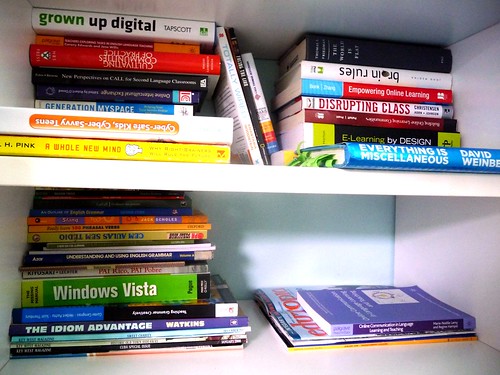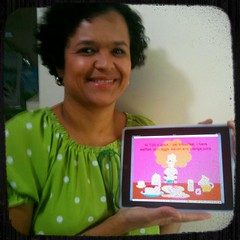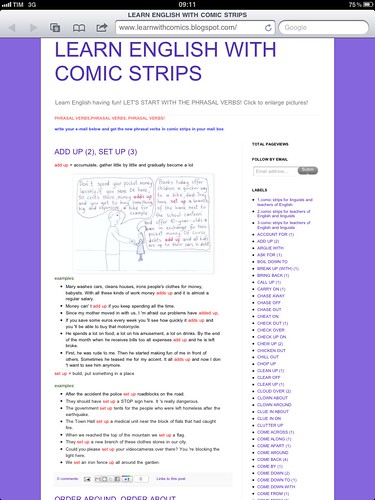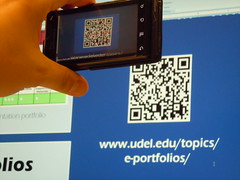I remember Cláudio as a very tall, charming teacher when I was still a student at the Binational Center we work in Brasília. Now, I feel terribly lucky to have Cláudio as a co-worker, always inspiring us with his fantastic activities with movie segments. He saves us time, helps us have ready-to-use activities promptly available for our English classes. It can be grammar-based activities, topic-based warm-ups and follow-ups, all freely available for use at:
Just like Cleide,
our tecnophobe teacher who became a digital artist, Cláudio didn't know much about technology until the day he started having some training and repurposed his own professional path connecting his passion for films and technology to share what he was doing with others with the community of educators worldwide. In fact, every time we travel to a Conference, Cláudio is a popstar with a group of fans wanting to take photos and talk with him.
Learn more about this educator who has been enchanting and inspiring all of us for years at
Casa Thomas Jefferson.
>>Cláudio, just some years ago, you didn't know anything about blogging. What was the turning point for you? What made you realize it was time for a change?
I felt that I was not following the speed of the changes in the educational field, especially concerning the tools available on the web. I started feeling embarrassed when I realized that novice teachers were much more familiar with the new trends in education than I was. They mastered the technological aspects, but lacked expertise in teaching. On the other hand, I mastered the teaching expertise, but did not know much about technology. I could not be behind the teachers I was supposed to monitor and develop. This feeling was shared by most of the Coordinators at the Casa Thomas Jefferson. These Coordinators eventually decided to take a course with a knowledgeable teacher at the CTJ, Ronaldo Mangueira, who taught us the basics of blogging and wikis. He assigned us one piece of homework, which was a turning point in this process. We had to develop a blog. Because I already had many activities connecting movies and grammar, which were ready to be used, I decided to create my blog to share what I had been doing and show my teacher I would manage to do my homework. Then everything took place rapidly. It was amazing how it motivated me to go on. The results were immediate. The number of visitors, the positive feedback and awards the blog received in such a short time showed me that I was in the right track, so I felt compelled to keep on developing the activities and sharing them with my readers. I think it was a wise decision.
>>You post a video activity with a grammar point handout every single week on your blog for free. Why free? What are your drives for giving so much to the community?
Many people have been talking me into charging for the worksheets or the site access. I refuse to do so. My main purpose is sharing. Teachers must help each other. How can a teacher in Russia or in Korea possibly compete against me? People with little access to technology or who are taking teaching training courses profit
enormously from my work. I am sure that I have been receiving much more in return by providing this free material than I would be if I had been charging for the use of the material. I gain by giving
presentations, relating with different teachers and institutions worldwide, giving short teacher development courses, and by fulfilling my generous way of being, sharing what I think I can do best. I also profit from other people’s work on the web, so my activities are just my share. I’ve been receiving many activities from my readers who want to share theirs too. I always publish them with the proper credits and I also use them in my classes. Most of them are excellent tasks. We end up helping each other.
>>How have you benefited from the community of educators who follow you? Any funny or touching stories about your followers?
Many experts in the teaching field have contacted me. We share links, ideas and knowledge. Famous professionals of the area have mentioned my work on important websites, such as Universities, Colleges, Governmental Organizations, among others. I have given interviews, made online presentations, and become a well-known reference in the use of videos and movies to teach grammar. This is simply fantastic, considering that Movie Segments to Assess Grammar Goals is turning three-years old in October 2011.
Readers have been sending messages of how their professional lives have changed after knowing my blog. Some of them say that their classes are much more fun now and that they use the segments practically every class. Some say they don’t teach a class without checking the blog out before they actually plan their lessons. I feel so pleased when teachers who have very few resources say that their students have become more motivated and participatory because of the activities. I also receive messages from students who start using my blog to practice the language, because their teachers let them know about the blog. And they do it spontaneously, just because they like the site. Just last week I received a message from a teacher from Malaysia, and she said that she was about to quit teaching for the lack of motivation and interest from her students in a small village where she lives in the cold mountains of the country. They hardly have access to movies or TV programs in English where they live in and their contact with foreigners is rare, which hindered the students’ intrinsic motivation to learn English . She said that her students are so eager to have English classes nowadays that she has started developing video activities herself. One of her activities will be shared in one of my future posts. She sent me pictures of her students using my blog. I almost cried seeing them! Another touching moment was when a teacher in Canada sent me a message with the topic: URGENT. The text said – “Claudio, I love you and your activities. You have saved my life so many times. I’m teaching a class on Dangling Modifiers on Monday. Can you prepare something for me. I am in complete despair without anything interesting for my students. Please HELP!!!”. Well, I did something with the movie “The Devil Wears Prada” for her. Three weeks later, I received a jar of Maple Syrup from her via snail mail. I loved it.
>>Why did you feel the need to keep adding to your Movie Segments to Assess Grammar Goals blog and creating another blog - Movie Segments for Warm-Ups and Follow-Ups?
I think I can’t stop feeding my blogs now. My readers expect a new post every week. They send messages if I am one day late with the post, for example, asking what happened. Moreover, new blockbusters and clever movies come out every week, many of them full of rich material. I simply cannot see a scene that can be used in class and ignore it. How can I leave the Twilight series out, for example? I have a lot of material already prepared for the next couple of years, ready to be published, so I don’t think I will ever stop doing it.
I had the need to create Movie Segments for Warm-ups and Follow-ups because many teachers at Casa Thomas Jefferson and other readers of mine know that I am a movie buff, so they usually ask me if I know a scene to lead some topics in, such as weddings, genetic engineering, cloning, travel hassles, among others. Besides, I also make use of segments to brainstorm new topics, readings, and for my conversation classes, so I decided to create another blog for that purpose. It is funny because both blogs have different audiences. This new blog attracts a lot of ESL and private teachers. In fact, it is a success too. The number of visitors increase every week. It contains activities and tasks that can be used just for 10 minutes or for a whole 120 minute-class. This is one of the reasons why teachers enjoy it, I guess.
>>I know you have a very interesting creative process to have the video segments ready for the educators. Can you tell us a little bit about it? How do you prepare the activities?
I’m not sure how it really happens. I have always prepared grammar activities based on movie segments, but I believe that technology nowadays has provided me with the tools I needed to store and share what I have always done. I usually see lots of films and I try to focus on how I can use scenes to practice grammar. However, I believe that practice makes perfect, so I have developed the skill to see movies with different eyes, which I call “grammar eyes”.
There are two ways of using my “grammar eyes”. One of them is to look for a specific grammar point when I see a blockbuster movie. So, if I’m looking for something to contrast the use of the simple past x past perfect, for instance, I already know I need a scene with a sequence of actions that take place during one single scene. This way I will manage to have a context that provides me with two actions that happen in the past, one before the other, and I will have enough input to use the tenses I’m looking for. The second way is when the movie has a scene that is simply perfect for a certain grammar goal. For example, I’m seeing a movie and there is a scene that shows a period of time, or activities which a character has performed during an unfinished period of time. This means I can use it for the present perfect tense. Modals for speculations must have a scene with an unexplained mystery. For the passive voice, you must find a scene with a series of actions. To contrast the past continuous and the simple past tenses, you must look for a scene in which several activities take place at the same time. I do not look for the grammar point in the lines the
characters say during the scene – sometimes I am lucky enough to have one or another scene like that – but I look for a context that allows a movie scene with certain characteristics to be used. This way teachers do not have to depend on my scenes, but they will manage to develop their own activities with the DVDs they have at home. The scene must be contextualized so you don’t have to explain what had happened before the snippet, and it can’t be longer than 7 minutes. Otherwise, students get distracted and don’t focus on the grammar point. I usually go to the movies with post-it notes so I can remember the scenes I need, but this is something I do, nobody will ever do it.
>>Have you changed anything in the process along the way?
No, I have not changed the process, which is easier for me now, though. I can identify useful scenes faster. Now that I am familiar with more webtools, the process is more practical. Editing the scenes, for example, used to be a hassle for me, but now it is a piece of cake. But the rationale behind the creative process is pretty much the same.
>>Any other plans for the future? Next steps?
These blogs have kept me busy for a while recently. Preparing the activities is time-consuming, and so is feeding the blogs, responding to comments, formatting other readers activities, online presentations on the subject, and so on. My main goal is to keep on promoting them and give presentations and courses about them. I’m collecting the material for a future publication or a book as well. I wish I had longer days to do everything I would like to.
>>A sentence of advice to EFL teachers around the globe:
It is never too late to update your technological knowledge. If you have a good concept or idea, it will eventually work out. Besides, sharing is extremely rewarding. We make use of the web to improve our own classes, why not share and help other fellows too? Don’t give up. If I managed it, you may manage it as well.























